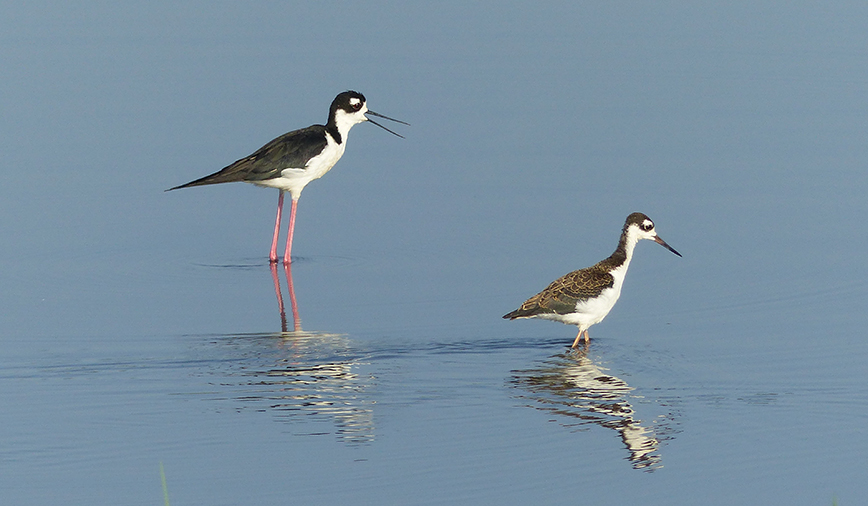This summer’s rains have left a host of lingering effects, including robust gardens, mosquitoes and fuddles.
If you’re like most folks, you’re probably enjoying the beauty and bounty of that first result and slapping and cursing the second. But unless you’re a birder, you’re likely scratching your head at the third.
A fuddle, or fluddle, is a flooded farm field puddle. While these wet depressions aren’t so good for crops, they make wonderful habitat for invertebrates, and therefore…shorebirds. That’s right, those birds you might usually associate with beaches and coastlines flock—when there’s enough rain—to farm country.
Lately, local birders have been abuzz about a fuddle on Route 47 in Sugar Grove. The reason? A few weeks ago a rare bird species, the black-necked stilt, was spotted foraging in the mud.
Himantopus mexicanus, which field guides describe as breeding in shallow wetlands of the western and southeastern United States, was poking around, clear as day. Even better, it wasn’t just one individual blown off course by a storm. Nope. An entire family–two adult black-necked stilts, or BNS, and three juveniles—were seen, suggesting that breeding had occurred right here in Kane County.
My luck and schedule being what it is right now, I haven’t been able to make it to Sugar Grove to see these wondrous birds myself. But John Heneghan, an avid birder from Big Rock, has been following the BNS story since the start. He graciously agreed to answer some questions and bring all Good Natured readers up to date.
GN: When did you first become aware of black-necked stilts at the fuddle? How many did you see?
JH: On July 19, Jude Vickery, a Kendall County birder, reported the stilts at the Route 47 fuddle on IBET (Illinois Birders Exchanging Thoughts, a dandy listserv). I live 4 miles from the fuddle, so I grabbed my scope, binoculars and camera and went over there. I was familiar with the fuddle as I have seen shorebirds there in the past and counted the fuddle for the Spring Bird Count. I saw two adults and three juveniles in the water. I did not stay at the site long as I did not want to disturb the stilts.
GN: On a scale of 0 (say, a house sparrow) to a 10 (say, a flamingo, not the plastic kind) how rare would you rate black-necked stilts for our area?
JH: I would say the stilts rate a 7 as they are seen infrequently in spring, but seem to be becoming more common. A stilt was reported at Nygren Wetlands near Rockton, IL a few days ago by Dan Williams. Most bird guides do not show stilts as nesting in IL. But they have been nesting at Emiquon and Chautauqua National Wildlife Refuges on the Illinois River near Havana.
GN: Has breeding been confirmed at this site?
JH: I had a conversation with Matthew Cvetas , who does the Rare Bird Alert for IL and with Tim Balassie from Kane County Audubon about the stilts and whether they had nested there or stopped there or nested nearby. Matthew and Tim both thought they were too young to fly.
Matthew also mentioned that a pair of stilts had nested in the Kankakee area last summer. This (Sugar Grove location) would be the farthest north stilts had nested in IL and the first time they had nested in Kane County. I spoke to Jon Krapfl, a biology tech with the US Fish & Wildlife Service at Horicon National Wildlife Refuge in WI where stilts nest. Jon also thought they had nested at the fuddle or nearby. Stilts are seen at Montrose Beach on Lake Michigan in spring as they migrate north to Horicon.
GN: It sounds as though this pair’s number of juveniles has decreased over time. Any guesses as to what may have happened to them?
JH: When I first went to the fuddle, there were three juveniles. A few days later there were two. I was there Sunday July 31 with Jerry Goldner, a birder from Chicago. We saw an adult bald eagle fly over and the adult stilts immediately gave chase. They harassed the eagle till it flew away. I have seen the adults chase yellow legs, a types of shorebird, and go after feeding mallards on the fuddle.
I went by the fuddle Monday August 1 in the morning and there was only one juvenile. I went back in the evening and still one juvenile to be seen. It could have been the eagle, or some other raptor. Maybe a coyote or a fox as the fuddle is surrounded on the west, south and north sides by soybeans.
GN: What do you suppose the birds found attractive about this fuddle?
JH: Stilts like open shallow water to nest near. I believe there are other areas close by that are holding water. I wonder if this is their first time nesting here.
GN: What other species of shorebirds are present?
JH: I have seen spotted, least and semipalmated sandpipers, lesser and greater yellowlegs, killdeer, great egrets and great blue herons there.
GN: Do you care to predict whether the stilts will return next year?
JH: Stilts have site fidelity, so I would not be surprised to see them back next year. It would depend on whether the fuddle had water, not sure if having corn would make a difference
John also reports that the juvenile flew to the fuddle with its parents on August 4, indicating that the youngster can fly. This new skill, along with the fact that BNS overwinter along southern coastlines, means these local stilts won’t be here much longer. But, fingers crossed, they—and ample rainfall, and the fuddle—might well return in 2017.
Pam Otto is the manager of nature programs and interpretive services at the Hickory Knolls Discovery Center, a facility of the St. Charles Park District. She can be reached at 630-513-4346 or potto@stcparks.org.

